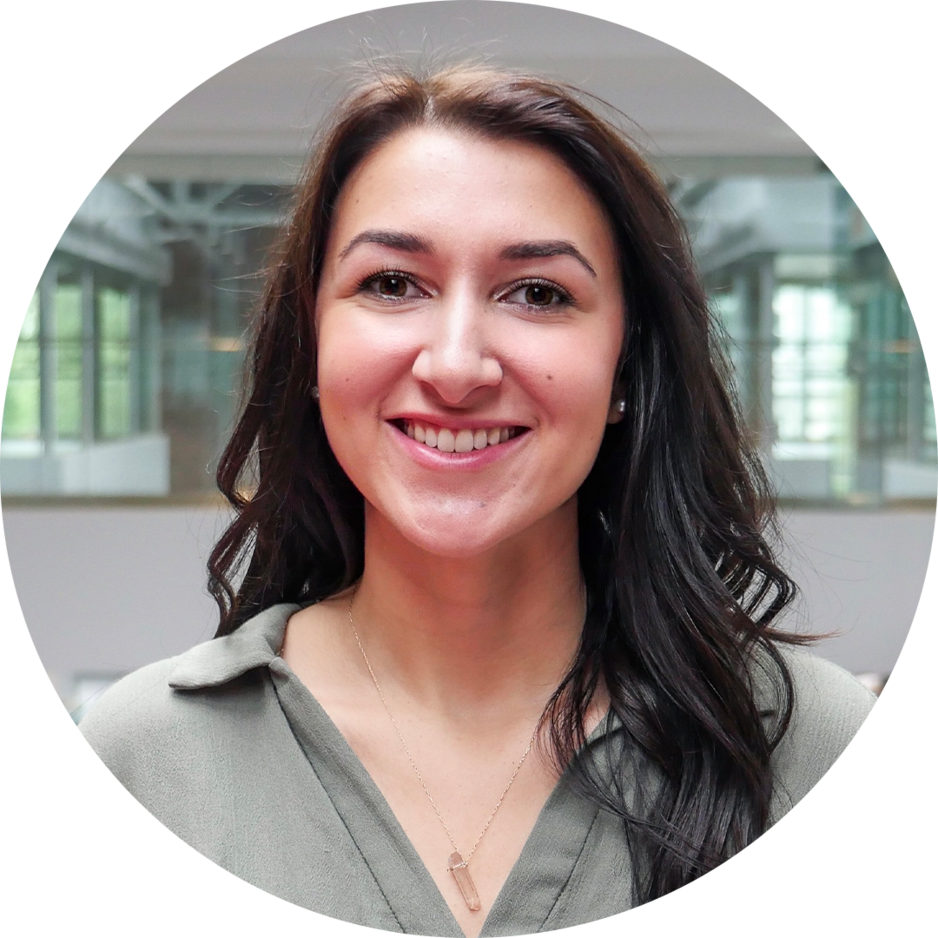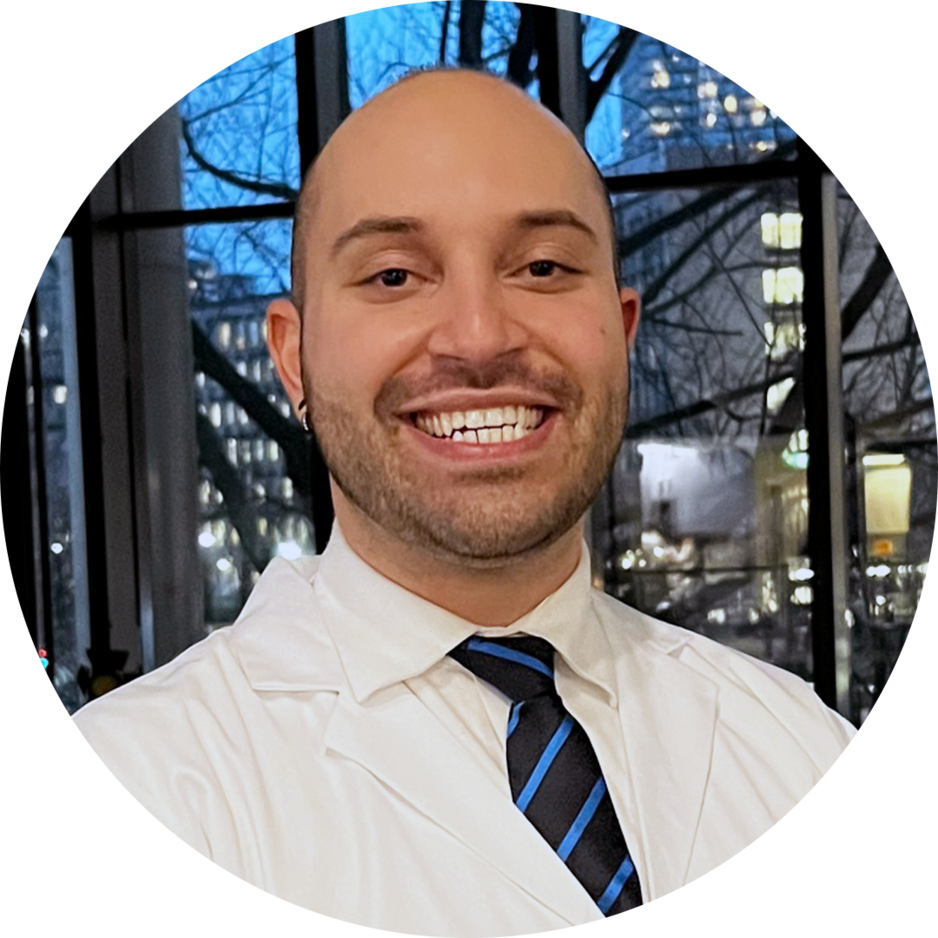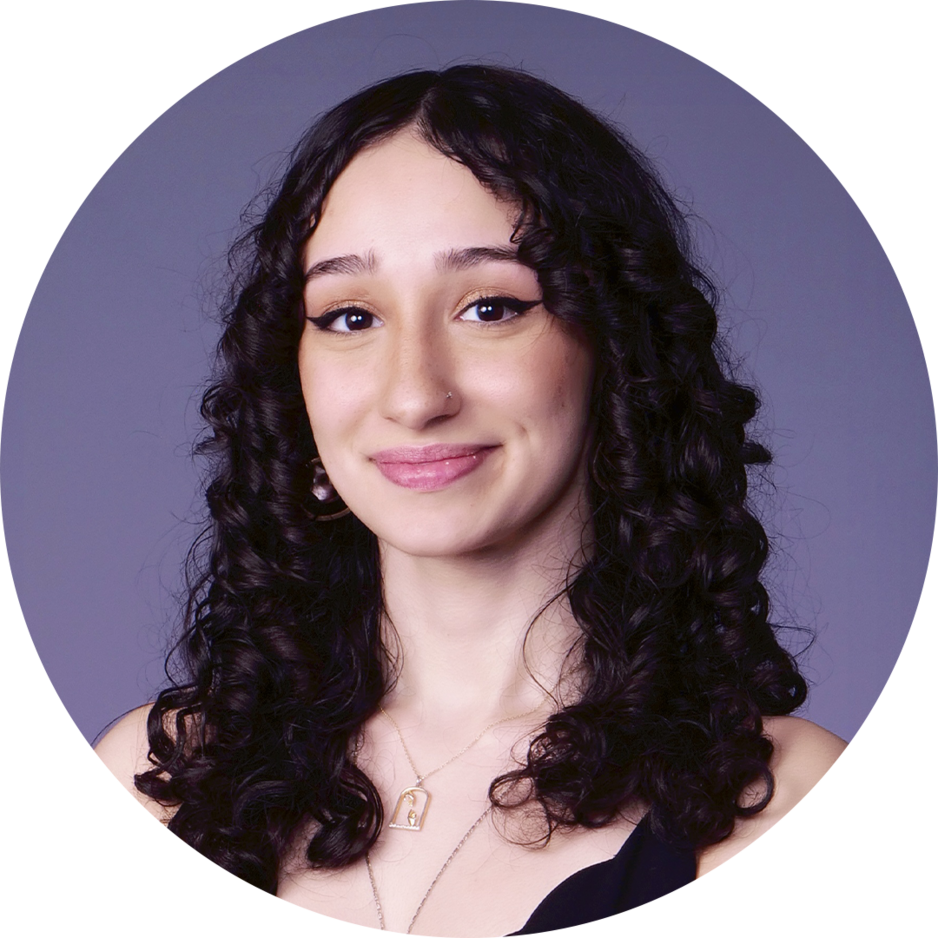As they cross the stage at U of T's Convocation Hall, Doctor of Pharmacy (PharmD) graduates from the Leslie Dan Faculty of Pharmacy reflect on years marked by hard work, shared experiences, and a dedication to serving patients and communities.
Among those who are Next in Rx are Natalie Chaput, Adam Da Costa Gomes, and Yas Zareyan of the 2T5 PharmD class.
These graduates look back on their final year shaped by hands-on learning and leadership, experiences that left a lasting impact and helped shape the pharmacists they’re becoming.
Natalie Chaput
Pronouns: she/her
Hometown: Ottawa, Ontario
- 1. What have been some of the most rewarding or memorable experiences during your time in the program?
-
One of the most rewarding aspects of the program was the opportunity to rotate through a wide variety of patient care settings during both Early practice experience (EPE) placements and the Advanced Pharmacy Practice Experience (APPE) year. These experiences allowed me to interact with patients in both hospital and community settings, and also gave me insight into what some non-direct patient care roles for pharmacists can look like.
A particularly memorable placement was my EPE-2 at the Hospital for Sick Children, in the hematology/oncology and solid organ transplant units. It was my first introduction to inpatient hospital pharmacy, and I learned so much from both the rotation and my co-preceptors. I also had the chance to work with a more specialized and vulnerable population, which taught me about the nuances of paediatric care and the differences in how these patients are treated compared to adults.
These varied experiences gave me a deeper appreciation for the adaptability and expertise required in different practice settings, and have helped shape my understanding of the many ways pharmacists can contribute to patient care.
- 2. Is there someone who made a big difference in your journey?
-
During my ICU rotation, I had an amazing preceptor who truly shaped how I approach patient care. They consistently emphasized the importance of interprofessional collaboration and its impact on patient outcomes. Their mentorship provided me with not only clinical guidance but also valuable insight into how pharmacists can contribute meaningfully within a team.
What stood out most was how encouraging they were. They made me feel valued and included as a student, fostering a space where I could learn, ask questions, and challenge myself to think critically. Their ability to clearly explain complex concepts and share their deep knowledge of pharmacotherapy in critical care made a lasting impression. It was inspiring to see how they balanced expertise with compassion and fostered a collaborative approach with the entire healthcare team. Their guidance and support have helped me grow in confidence as I prepare to take on future clinical roles.
- 3. Tell us about a recent rotation or placement. What was the setting and what did you take away from the experience? Have any of your rotations shifted or strengthened your career goals?
-
I had the opportunity to complete an APPE rotation in the Medical-Surgical Intensive Care Unit (ICU) at Toronto General Hospital, after taking the Pharmacotherapy in Critical Care elective in third year. The complexity of critical care medicine had always intrigued me, and this rotation gave me a firsthand look at the challenges and rewards of managing patients with multiple comorbidities and rapidly changing conditions.
In the ICU, I was exposed to a wide range of therapeutic areas—from shock and sedation management to emergency toxidromes and renal replacement therapy. I learned the importance of clinical precision, collaboration, and adaptability in such a high-acuity environment. The rotation also reinforced the critical role pharmacists play in delivering timely, evidence-based recommendations to support interprofessional decision-making. What I took away most from this experience was the power of teamwork and the importance of advocating for patients. I developed greater confidence in my clinical judgment, and the rotation deepened my appreciation for patient-centred care.
This APPE rotation in the ICU truly solidified my desire to pursue pharmacy residency training and further develop as a clinical pharmacist, with the goal of potentially completing a specialized residency in critical care down the line. It showed me how pharmacists can have a meaningful impact on patient care—especially in complex, fast-paced settings—and inspired me to continue challenging myself professionally.
- 4. Were you involved in any student groups, leadership roles, research, or extracurriculars?
-
Throughout my time in the PharmD program, I was actively involved in various student organizations and initiatives that enriched my educational experience and helped me connect with the broader pharmacy community. I participated in the Pharmaceutical Industry Primer and Education (PIPE) club, where our team facilitated discussions and events focused on exploring alternative career paths for PharmD graduates in the pharmaceutical industry. I was also involved with Canadian Association of Pharmacy Students and Interns (CAPSI) during Pharmacy Appreciation Month, taking part in outreach initiatives such as Kids in Medicine (KIM) and Pharmacy Outreach Days (PODs), which aimed to provide health education to the community through presentations and discussions.
One particularly meaningful extracurricular activity was my role as a Seniors Outreach Volunteer with Central Neighbourhood House. Collaborating with two other healthcare professional students at U of T, we regularly connected with a senior in the community through phone calls and organized activities. This experience fostered intergenerational connections, strengthened my communication and leadership skills, and gave me the chance to get to know people I may not have otherwise crossed paths with!
- 5. How have you stayed connected to the pharmacy community during your time in the program—and how do you plan to stay connected after graduation?
-
I’ve stayed connected through mentorship, participation in professional development opportunities, and attending club events throughout the year. After graduation, I plan to remain engaged by staying active in professional organizations, attending conferences, and mentoring future pharmacy students!
- 5. What’s next for you after graduation?
-
I’m excited to be starting my pharmacy residency at The Ottawa Hospital, where I’ll continue developing my clinical skills and gain experience across diverse practice settings!
- 6. What kind of impact do you hope to make as a pharmacist?
-
I hope to provide patient-centred care, advocate for the safe and effective use of medications, and inspire future pharmacists. I aim to contribute meaningfully to interprofessional teams, make a difference in patients’ lives through empathy and expertise, and stay actively engaged in the pharmacy community to help advance and advocate for the profession.
Adam Da Costa Gomes
Pronouns: he/him
Hometown: Mississauga, Ontario
- 1. What have been some of the most rewarding or memorable experiences during your time in the program?
-
The single most rewarding experience, in my view, was the year I spent as student body president. Leading the Undergraduate Pharmacy Society (UPS) is a major undertaking that few take on, and I’m so thankful to have been elected by my peers across all years to serve in that role.
Other highlights include Phrosh Week—both as a participant and as a planner—sitting on various Faculty committees, consulting on Faculty initiatives, and even being a model for new Faculty merch!
Outside of student leadership, it’s been the great friendships I’ve made along the way—the delicious meals, the inside jokes, and the late nights of...studying!
- 2. Is there someone who made a big difference in your journey?
-
I had to pick just one person, it would be Assistant Professor Andrea Swanson. She has this infectious positivity that makes you genuinely excited to attend her classes and learn. She’s the person who lit the spark of hospital care in my mind, and that’s what ultimately shaped my path of choice.
As a past UPS president herself, she was always willing to be a sounding board for me when I faced challenging leadership decisions. I have so much respect for her and everything she does for the Faculty, and I’m incredibly thankful I had the opportunity to be her student.
- 3. Tell us about a recent rotation or placement. What was the setting and what did you take away from the experience? Have any of your rotations shifted or strengthened your career goals?
-
As part of Block 9 of my APPE year, I completed a rotation in the Medical/Surgical/Neurology ICU at Toronto Western Hospital. It was a busy five weeks filled with traumatic reasons for admission, but also with hard work and excellent patient care.
Sure, there are studies about the impact of pharmacists on mortality in ICU patients—but to experience it firsthand, day after day during rounds, was incredible. It reinforced my desire to begin my career on the hospital path.
I walked into pharmacy school knowing, in my bones, that I was going into industry—nobody could tell me otherwise. But I was lucky enough to land an EPE-2 position at a hospital near where I lived at the time, in the same network as the hospital where I was born—and that’s where everything changed
There was something about providing care in a hospital setting that was unlike anything I’d ever experienced. It completely shifted my direction and intentions for my life after graduation.
- 4. Were you involved in any student groups, leadership roles, research, or extracurriculars?
-
While I’ve already mentioned UPS, I had the privilege of serving on council for three years—first as secretary, then president, and finally as past president. Through these roles, I had the opportunity to be involved in Faculty work that most students could only dream of. I was one of the students asked to greet President Gertler during his official visit to the Faculty. I represented our program at a reception at the U of T President’s Estate, attending alongside high-impact donors. I even got to model for Faculty merchandise!
I sat on various governance committees, including Faculty Council, the Curriculum and Assessment Committee, and the PharmD Program Committee. I also represented students at Faculty open houses—both for prospective applicants and for donors—and was part of the Student Advisory Group for curriculum renewal and the development of the three-year PharmD.
Alongside friends and colleagues, I helped organize two Ontario Pharmacy Student Integrative Summit (OPSIS) conferences. During my time on UPS, we hosted a wide range of student events, including the launch of the now-popular building-wide Trick-or-Treat event.
- 5. How have you stayed connected to the pharmacy community during your time in the program—and how do you plan to stay connected after graduation?
-
In time, I would love to become a Clinical Instructor or Preceptor for PharmD students!
- 5. What’s next for you after graduation?
-
Nothing is set in stone just yet—and honestly, I almost prefer it that way. I had a plan for what I wanted to do right after pharmacy school, but things didn’t unfold exactly as I’d hoped at the time. And that’s okay—because it means all options are still open to me.
I’m planning to take a bit of time before starting the job hunt to visit friends and family I haven’t been able to spend much time with over the past four years. After that, it’s off into the workforce!
- 6. What kind of impact do you hope to make as a pharmacist?
-
Of course, everyone wants to leave a good—or positive—impression on their patients, and I absolutely feel the same. But more than anything, I want my patients to feel like they can be open with me. I don’t want them to feel like they have to lie or hide information—whether it's about side effects, supplements, or anything else that could affect the care I provide. Building that kind of trust is what truly matters to me.
Yas Zareyan
Pronouns: she/her
Hometown/Where you grew up: Tehran, Iran; Vancouver, British Columbia
- 1. What have been some of the most rewarding or memorable experiences during your time in the program?
-
One of my most memorable experiences in the PharmD program was participating in Pharmacy Appreciation Month (PAM) through CAPSI. I was involved in several projects, including the Kids in Medicine Initiative (KIM), where I helped create and deliver presentations on the harms of vaping and smoking to elementary school children across the GTA. I also took part in Pharmacy Outreach Days (PODs), where my peers and I developed a poster on opioid use and naloxone. We presented it at various community pharmacies, offering education on how to recognize signs of overdose and use naloxone kits. In addition, I contributed to the development of a video case for our Interprofessional Education (IPE) event on bipolar disorder, which supported collaborative discussions among students from multiple health disciplines. PAM was an extremely rewarding and memorable experience, as it allowed my colleagues and me to apply our learning beyond the classroom and give back to our community in meaningful ways.
- 2. Is there someone who made a big difference in your journey?
-
I had two preceptors during my 10-week institutional APPE placement who had a significant impact on my journey: Karen Ng at the Toronto Academic Pain Medicine Institute (TAPMI) and Becky Wright in the Ambulatory Surgery Unit. I spent five weeks with each of them, and through their mentorship, I came to deeply understand the pharmacist’s role—particularly why we are integral to an interprofessional team.
During my time at TAPMI with Karen, we were responsible for managing patients with complex, treatment-resistant chronic pain. I quickly noticed that all of our patient visits were interprofessional in nature. While the physician conducted the physical exam and arranged referrals, Karen and I focused on the pharmacological strategy. She had a remarkable ability to bring structure and clinical insight to cases layered with medical, psychological, and social complexities. Karen always pushed me to be thorough in my assessments and encouraged me to explore advanced topics in pain management, such as using Suboxone® for chronic pain or the therapeutic role of cannabinoids. Her teaching style was thoughtful, clinically grounded, and always centred on optimizing patient care and ensuring beneficence.
Becky is, without a doubt, one of the most dedicated preceptors I’ve had. She made it clear from the start that my learning and growth were a priority. A notable case she recommended I follow involved a patient with resistant hypertension undergoing an adrenalectomy. The patient had primary aldosteronism, and I witnessed their blood pressure drop to normal immediately following surgery—it was incredible to see classroom learnings directly translate into practice. Becky also let me work alongside her in the Post-anesthesia Care Unit (PACU), which allowed me to interact directly with nurses about my patients and observe how the interprofessional team engaged with her. From their constant questions, it was clear she was a trusted source of evidence-based information.
What stood out even more was how seamlessly she promoted interprofessional collaboration. She encouraged me to engage with nurses, anesthesiologists, and surgeons. As soon as patients came out of surgery, we would be at their bedside receiving the hand-off. Every day, various health care professionals would seek her out with questions. Watching her—confident, clear, and respected by the entire team—showed me why pharmacists are pivotal in the circle of care. Her input was clearly valued and trusted by all.
- 3. Tell us about a recent rotation or placement. What was the setting and what did you take away from the experience? Have any of your rotations shifted or strengthened your career goals?
-
My Non-direct Patient Care (NDPC) APPE placement was at ODAIA, a Toronto-based tech startup that uses AI and predictive analytics to optimize commercial operations in the pharmaceutical industry. I worked on the Business Acceleration team to help translate data into actionable insights for our pharmaceutical clients. Internally, I contributed to the development of therapeutic frameworks that aligned our team with client priorities—particularly important given that most team members came from non-pharmacy backgrounds. These frameworks helped ensure we spoke a shared language before engaging with clients. Externally, I supported the creation of engagement reports and helped assess the performance of field representatives, using data to guide strategy and enhance client value.
This innovative, start-up environment allowed me to blend my clinical knowledge with business strategy—something I had never explored before. It not only strengthened my interest in medical affairs but also showed me how pharmacists can bring clinical expertise into non-traditional roles that drive healthcare innovation. It opened my eyes to the value of data-driven decision-making in improving patient access and provider engagement. It was exciting to see that my pharmacy skill set could be applied in a niche area like the tech space. This experience helped clarify and strengthen my long-term goal of working at the intersection of healthcare, data, and strategy—ideally in a role that continues to challenge me to think from a systems-based, analytical lens.
- 4. Were you involved in any student groups, leadership roles, research, or extracurriculars?
-
I was involved in several student groups and extracurriculars throughout my time in the program. The three clubs I participated in consistently over all four years were Pharmacy Awareness of Indigenous Health (PAIH), Pharmaceutical Industry Primer & Education (PIPE), and Students for Optimizing and Advocating Pharmacy Endeavours (SOAPE). I held a variety of leadership positions within these groups, including Initiatives Director, Class Representative, and President.
In my first year, I was also the captain of the pharmacy women’s basketball and volleyball intramural teams. This was an especially rewarding experience, as working together on a sports team helped my peers and me grow closer and strengthen our bond. It also gave us all a much-needed break from studying!
- 5. How have you stayed connected to the pharmacy community during your time in the program—and how do you plan to stay connected after graduation?
-
Throughout the program, I’ve stayed closely connected to the pharmacy community through my involvement in student organizations such as PAIH, SOAPE, PIPE, and by helping with PAM through CAPSI. These roles allowed me to advocate for equity in pharmacy education, organize professional development opportunities, and collaborate with students and faculty across all years of the program. I also participated in various mentorship programs, including PharmaSEE and Big Siblings, which helped me build lasting relationships with mentors and explore different career paths within pharmacy.
Looking ahead, I plan to stay engaged through mentorship, contributing to pharmacy innovation and advocacy initiatives, and staying active in alumni and professional networks. I also enjoy staying connected to the field through newsletters such as Pharmacy Practice+Business and Medscape.
- 5. What’s next for you after graduation? What kind of impact do you hope to make as a pharmacist?
-
After graduation, I plan to rejoin ODAIA and continue working at the intersection of pharmacy, technology, and data-driven insights. Over the next five years, I hope to be part of a broader shift in healthcare—one that embraces AI and predictive analytics to drive smarter, safer, and more efficient care. Pharmacists have already seen the benefits of automation—such as dispensing technologies—in improving safety and workflow. I believe AI is the next step in that evolution, offering system-based tools that not only support healthcare decision-making but also anticipate patient and provider needs.
During my time at ODAIA, I saw how AI can uncover trends in prescribing and engagement that would be nearly impossible to detect manually. Its ability to facilitate rapid data analysis allows healthcare professionals to gain a comprehensive understanding of prescribing patterns and behavioural trends. These insights enable healthcare teams to be more proactive, precise, and patient-centered. As outlined by ISMP Canada, system-level improvements—especially those that leverage computerization and automation—are among the most effective strategies for strengthening healthcare. I’m excited to contribute to this shift by bringing my pharmacy clinical expertise into the field of tech innovation. By being at the forefront of this change, I hope to help create new roles for pharmacists that go beyond what we traditionally envision when entering the program.
More News
Image

How Bebe Simelane’s summer research is fueling her passion for science
Through hands-on research, mentorship, and exposure to cutting-edge tools like AI, this USRP student is gaining the skills and confidence to pursue graduate studies and advance science.
Read More
Image

Faces of PharmSci: Kristy Scarfone
Co-supervised by Professor Jillian Kohler and Assistant Professor Jaris Swidrovich, MSc student Kristy Scarfone is researching how unregulated substance-related care and harm reduction vary across Ontario, with the goal of strengthening public health and showcasing pharmacists’ impact in this area.
Read More
Image

Research team aims to co-design diabetes and dementia support programs that meet community needs
Network for Health Populations funding will support collaborative project to improve health outcomes for immigrant communities in Mississauga.
Read More



